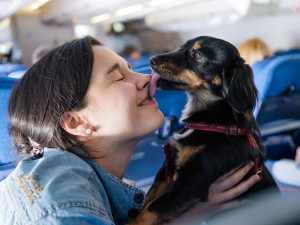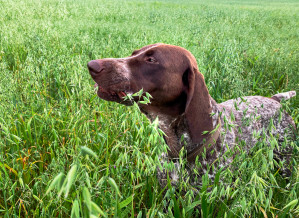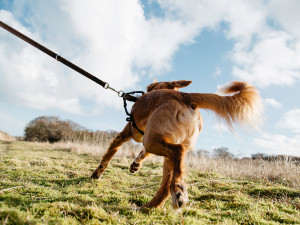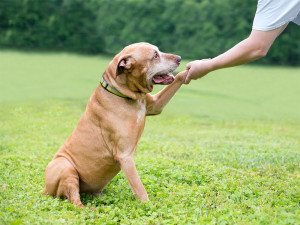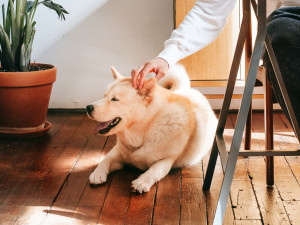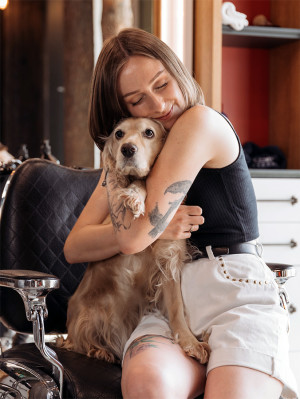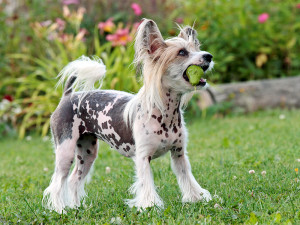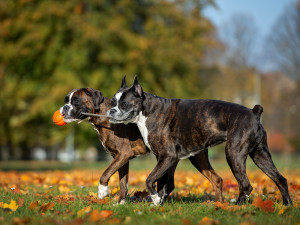9 Common Dog Myths (That Are Actually False)
Sorry to break it to you, you might not know your pup as well as you think you do
In this article:
Is a dog’s saliva cleaner than a human’s? Can dogs only see black and white? Do dogs only eat grass when they’re sick? Does a wet nose mean a healthy dog? Do dogs age seven years for every human year? Does a wagging tail mean a happy dog? What does a dog‘s yawn mean? Can you teach an old dog new tricks? Should you let a dog sniff your hand before you stroke them?
Navigating the world of dogs can be confusing at the best of times. What should you feed your dogopens in new tab? How many treats is too many treats? Why on earth do they do the infamous bum scoot? But throw in a whole host of commonly believed dog myths and misconceptions, and being a pet parent can turn into a minefield.
The truth is, some dog ‘facts’ that aren't actually facts have snuck under the radar for years, and whilst some of these common misconceptions around dogs are pretty harmless, other perpetuated dog myths can be dangerous for you and your dog. From their saliva to their senses, challenging these assumptions and unravelling the truth behind these common pup misconceptions can be the key to understanding your pup that little bit better.
Is a dog’s saliva cleaner than a human’s?
It’s a common misconception that a dog’s saliva is inherently cleaner than a human’s, but unfortunately your pup’s mouth isn’t actually the sparkling sanctuary of cleanliness they’d like you to think it is when they’re smothering you with kisses.
Whilst it is true, dogs do have certain antibacterial enzymes and proteins in their salivaopens in new tab that aid in wound healing, it doesn’t necessarily mean that their slobber is cleaner than a human's. As you’ve probably noticed, dogs like to lick things. A lot. Dogs use their mouths for a variety of activities, including eating, grooming and exploring the world around them, which means their saliva harbours a variety of bacteria, including some that can be harmful to humans.
One study found that a dog’s mouth can contain over 600 different types of bacteriaopens in new tab (compared to 615 in human saliva), most of which are not zoonotic, meaning they can’t be transferred from pup to pup parent. However, there can still be some crossover. Research has shown that dog saliva can contain bacteria such as Pasteurella, which can cause skin infections, and Capnocytophaga, which can lead to more severe complications in individuals with weakened immune systemsopens in new tab.
That being said, the risk of contracting an illness from a dog’s saliva is relatively low for most humans. Dogs fed a raw diet are more likely to pick up Escherichia coli (E coli) or Salmonella from their food, which can then be spread to humans, and those with more vulnerable immune systems (elderly, young or immuno-compromised, for example) can be more susceptible to zoonotic bacteria spread from pup to pup parent, so whilst your pup’s kisses may be filled with love, they’re not necessarily germ-free, and you should always exercise caution.
Dogs can only see black and white
For decades, it was widely believed that dogs saw the world in shades of grey, devoid of the vibrant colours that humans perceive. This misconception likely stems from early research that suggested dogs have fewer colour receptors in their eyes compared to humans. However, more recent studies have painted a different picture of canine vision, and the topic of dog vision isn’t exactly black and white (see what I did there?).
Whilst humans have three types of colour-detecting cells, or cones, in their retinas (red, green and blue), dogs only have two (blue and yellow). This means that dogs perceive the world in a more limited colour spectrum than humans do.
Despite their limited colour vision however, dogs have superior motion detection and night vision compared to humans, thanks to their well-developed rod cells. This adaptation allows them to excel in activities such as hunting or tracking at dawn or dusk. They also rely heavily on other senses, such as smell and hearing, to navigate their surroundings.
Dogs only eat grass when they’re sick
Ever caught your canine chum chowing down on some greens mid-walk and assumed they must be feeling under the weather? Think again. Whilst some dogs do eat grass to induce vomiting and relieve gastrointestinal discomfort when they have an upset stomach, it’s not always the only reason why dogs eat grass.
In reality, a dog might eat grass for a variety of reasons, ranging from instinctual behaviour to dietary supplementation. Some dogs enjoy grazing, or simply enjoy the texture or taste. For others, grazing on grass may simply be an enjoyable pastime or a way to alleviate boredom. Dogs are naturally curious, and natural foragers, so they may explore their environment by sniffing, tasting and even eating various objects, including grass.
Dogs may be instinctively drawn to grass due to its fibre content, which can aid in digestion and promote gastrointestinal healthopens in new tab. Grass also contains certain nutrients that may be lacking in a dog’s regular diet, prompting them to seek out greens as a form of dietary enrichment. A closer inspection of your pup’s diet might be the answer behind your dog’s grass-eating habits.
That being said, if your dog is eating an excessive amount of grass or showing signs of distress, such as vomiting or diarrhoea, it’s important to consult your veterinarian to rule out any underlying health issues. While occasional grass consumption is generally a harmless quirk, it’s essential to monitor your dog’s behaviour and ensure they’re not ingesting anything that could be harmful to their health.
A wet nose means a healthy dog
A wet nose has long been associated with a healthy pup, but the idea isn't entirely accurate. Whilst it’s true that a wet nose can indicate proper hydration and healthy mucus membrane function in dogs, it’s not the sole clue to their overall health, and the truth is a bit more nuanced.
A moist nose can indicate normal secretions and how hydrated your pup is. However, it can also be a sign of various health issues like allergies or respiratory infections. On the other end of the stick, a dry nose doesn’t always mean your furry friend is unwell, but certain health conditions, medications and age-related changes might cause a dry nose.
So whilst a moist nose can indicate a healthy dog, it’s not a foolproof sign. Factors such as humidity, temperature and activity level can affect nose moisture, and a dog’s nose can vary in moisture levels throughout the day, making it an unreliable barometer. Dogs may also lick their noses to clean them or to gather scent molecules, which can temporarily increase moisture, too.
Instead of relying solely on your dog’s nose moisture to calculate their well-being, pay attention to other signs of their health such as appetite, energy levels, coat condition and behaviour. If you notice any changes in your dog’s health or behaviour, it’s always a good idea to consult your vet for evaluation to be on the safe side.
Dogs age seven years for every one human year
While it’s a fun analogy ingrained in society for decades (where it came from I’ll never know), canine ageing isn’t as straightforward as multiplying by seven. The rate at which dogs age actually varies significantly, depending on factors such as size, breed and individual genetics. Smaller breeds tend to have longer lifespans and age more slowly compared to larger breeds. For example, a seven-year-old Chihuahua may be considered middle-aged, whilst a seven-year-old Great Dane would be considered a senior dog.
Different breeds may also be predisposed to certain health conditions that can affect their ageing process. For example, larger breeds are more prone to orthopaedic issues such as hip dysplasia, which can impact their mobility and overall quality of life as they age.
To more accurately assess a dog’s age in human years, veterinarians and researchers have developed more sophisticated methods to calculate ‘dog years’ based on the actual chemical changes in a creature’s (human or dog) DNA. These calculations take into account the breed-specific ageing rates and adjust for differences in size and lifespan.
One studyopens in new tab was able to develop an epigenetic clock for estimating a dog’s age in human years. Your pup’s age must be greater than one year, then that dog age is converted into a natural logarithm and that log is multiplied by 16, and then 31 added for a total. For example, if a dog is 14 years old, the natural log of 14 is 2.6390, multiplying that by 16 equals 42.224, adding 31 brings it to 73.2 (I personally think I’ll stick to ageing my pup in human years…)
A wagging tail means a happy dog
There’s nothing better than a wiggling bum running up to you when you’re a pup parent, and a dog wagging its tail is often interpreted as a universal sign of happiness and contentment. However, whilst tail wagging can indicate positive emotions, its meaning is more nuanced and context-dependent than commonly believed, and tail wagging can convey a number of emotions and intentions beyond just joy.
Dogs communicate primarily through body language, and their tails are a crucial part of their signalling repertoire. The speed, height and position of a dog’s tail can provide valuable insights into their emotional state and intentions. For example, a broad, high tail wag with loose movements is typically associated with a happy, confident dog. On the other hand, a low, stiff tail wag with rapid movements may indicate nervousness, insecurity or even aggression. A tucked tail between the legs often signals fear or submission.
The context of a tail wag is also essential for interpretation. Tail wagging in response to ‘stranger danger’ may indicate fear or caution, whilst tail wagging during play or social interactions often suggests excitement and positive engagement.
It’s important to remember that every dog is unique, and their body language may vary depending on their individual personality and past experiences. By paying close attention to your dog’s behaviour and body language, you can better understand their needs and emotions; ear position, body posture, facial expressions and vocalisations can all provide valuable insight into how your dog is feeling.
A yawn means your dog is tired
Yawning is commonly (and rightly) associated with fatigue or drowsiness in both humans and animals, but tiredness isn’t always the sole reason dogs yawn. Whilst dogs do yawn when they’re tired, they can also yawn for a variety of other reasons, including stress, anxiety or even as a form of communication. That yawn before they slump into bed? They’re probably exhausted from being so damn cute all day. A yawn when they bump into the local dog walker with a gang of seven pups? Not so much.
Yawning can be a calming signal for dogs, especially in social situations or when they’re feeling overwhelmed. Yawning can be a displacement behaviour – a way for dogs to cope with conflicting emotions or alleviate tension in social interactions – or your dog may be trying to communicate to other dogs or humans that they’re not a threat and want to avoid conflict. Dogs may also yawn as a way to relieve tension or anxiety. In stressful situations, such as a visit to the vet or a thunderstorm, dogs may yawn as a coping.
Research shows that contagious yawningopens in new tab – the phenomenon in which yawning is triggered by seeing someone else yawn – has also been observed in dogs, suggesting there could be an additional social component to the behaviour. Dogs may also yawn in response to seeing their owners or canine companions yawn, possibly as a form of empathy or social bonding.
You can’t teach an old dog new tricks
The old adage “you can’t teach an old dog new tricks” implies that older dogs are set in their ways and less receptive to learning new behaviours. Not only is the saying pretty ageist, it also couldn’t be further from the truth.
Dogs, regardless of age, possess remarkable cognitive abilities and are capable of learning new behaviours throughout their lives. Whilst older dogs may take a bit more time and patience to grasp new concepts compared to their younger counterparts, they can still thrive with positive reinforcement training methods. So don’t underestimate your senior pooch’s potential for learning and growth.
Engaging older dogs in mental stimulation and enrichment activities can also help keep their minds sharp and promote overall cognitive health as they age. Training sessions provide opportunities for senior pups to exercise their brains, maintain their problem-solving abilities and bond with their parents.
With a little patience, consistency and positive reinforcement, focusing on building trust and fostering a supportive learning environment, senior dogs can most certainly learn new tricks.
You should let a dog sniff your hand before you stroke them
The common advice to let a dog sniff your hand before petting them is based on the idea of allowing dogs to gather information about you through scent, which is an important aspect of a pup’s method of communication and social interactions. But whilst letting a dog smell you might be beneficial in certain situations, it’s not a strict rule that should apply to all pooches.
Some dogs may very well appreciate the opportunity to sniff your hand as a way of greeting and getting acquainted before moving on to physical contact, some may prefer direct interaction without a preliminary sniff and others might feel uncomfortable or threatened by hand movements towards their face (just imagine that interaction human to human, weird right?).
Instead, pay attention to cues such as relaxed posture, wagging tail and soft eye contact, which indicate that your dog is receptive to physical contact. Respect their boundaries, let them initiate contact if they’re comfortable and then lean in to giving them a good, proper stroke.


